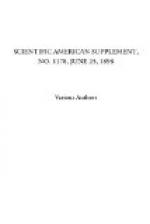There are numerous grades of reclaimed rubber, due to differences in the quality of stock used, and also to the different degrees of care used in its preparation, according to the requirements of manufacturers. The declared value of reclaimed rubber exported from New York during July, 1897, averaged 12.6 cents per pound, while the value of exports for September averaged only 9.1 cents. The average value for the eight months ending February 28, 1898, was 10.08 cents per pound. The total declared value of such exports for the fiscal year 1896-97 was $119,440, which, at the prices prevailing since, would represent considerably more than 1,000,000 pounds. Some of the material sold at home is known to bring less than any prices quoted above. “Mechanical” stock brings about two cents per pound more than “acid” stock of corresponding grade.
The collection of old rubber has acquired large proportions as an adjunct to the trade in junk or rags. Not long ago the estimated yearly collection of rubber shoes alone amounted to 18,000 tons, and since that time the business in bicycle tire scrap has also become very large. During the past ten years the price of old rubber shoes has ranged between $60 and $120 per ton in carload lots, being at present about $90 per ton. Some 1,500 tons of rubber scrap are imported annually by the reclaiming companies in the United States.
* * * * *
In the Baltic Sea there are more wrecks than in any other place in the world. The average throughout the year is one each day.
* * * * *
ENGINEERING NOTES.
The Austrian government has ordered thirty-seven engines arranged to burn kerosene, for use in the Arlberg tunnel, in which lack of proper ventilation at present causes the tunnel to remain filled with smoke.—Uhland’s Wochenschrift.
One of the first essentials to modern military enterprise is the establishment of a military railway system for war purposes. To be in a position to carry out efficiently and speedily what we may expect to be called upon to do on the outbreak of serious war, previous preparation in time of peace is an absolute requisite. In connection with General Sherman’s operations in Georgia, during the American civil war, an army was supplied for six and a half months over a line 473 miles long. The corps of workmen was 10,000 strong, and on one occasion replaced 35,000 sleepers and nine miles of rails in seven days. The true defense of the line was effected by the engineers always having men and material ready. In spite of the large and skilled railway population on which the army could call, and of the fact that practically the nation was in arms, it was found extremely difficult to keep this railway construction corps together until they were placed under a severe military discipline.—United Service Gazette.




